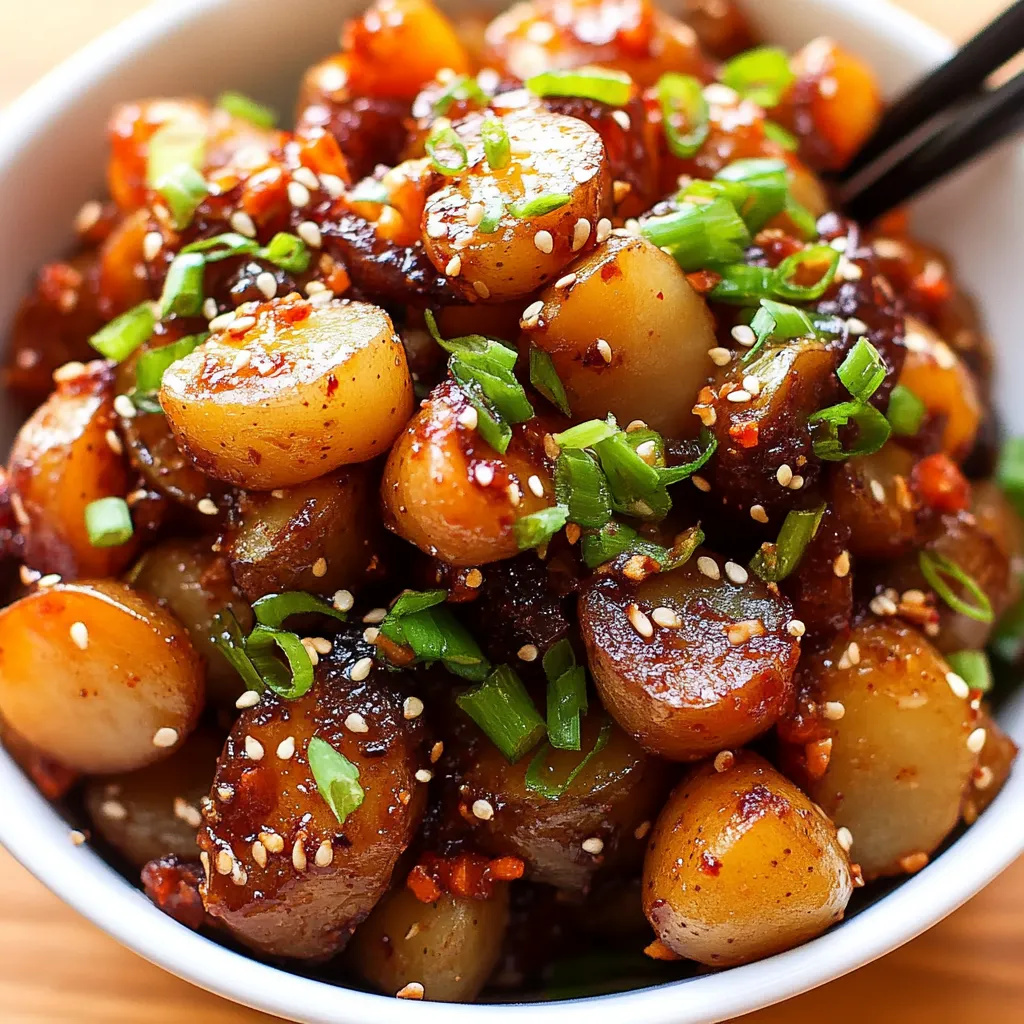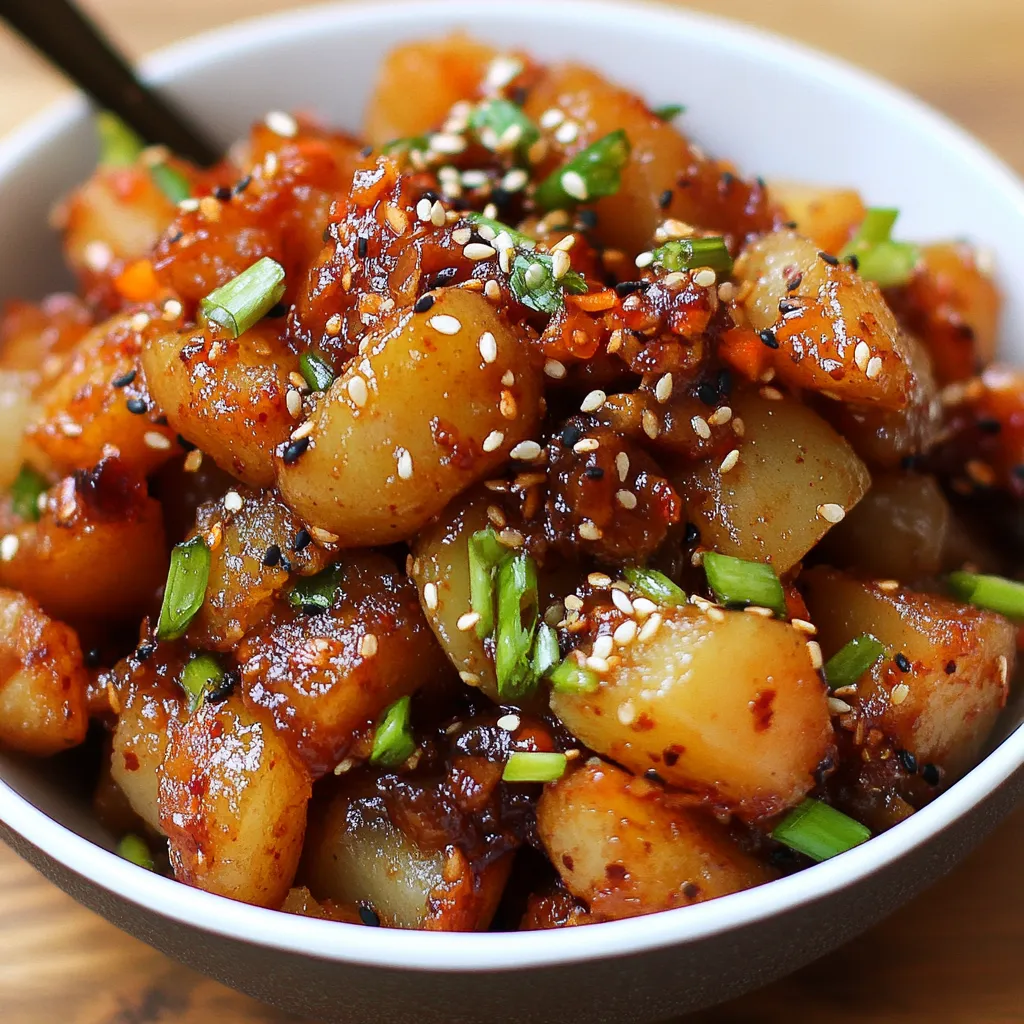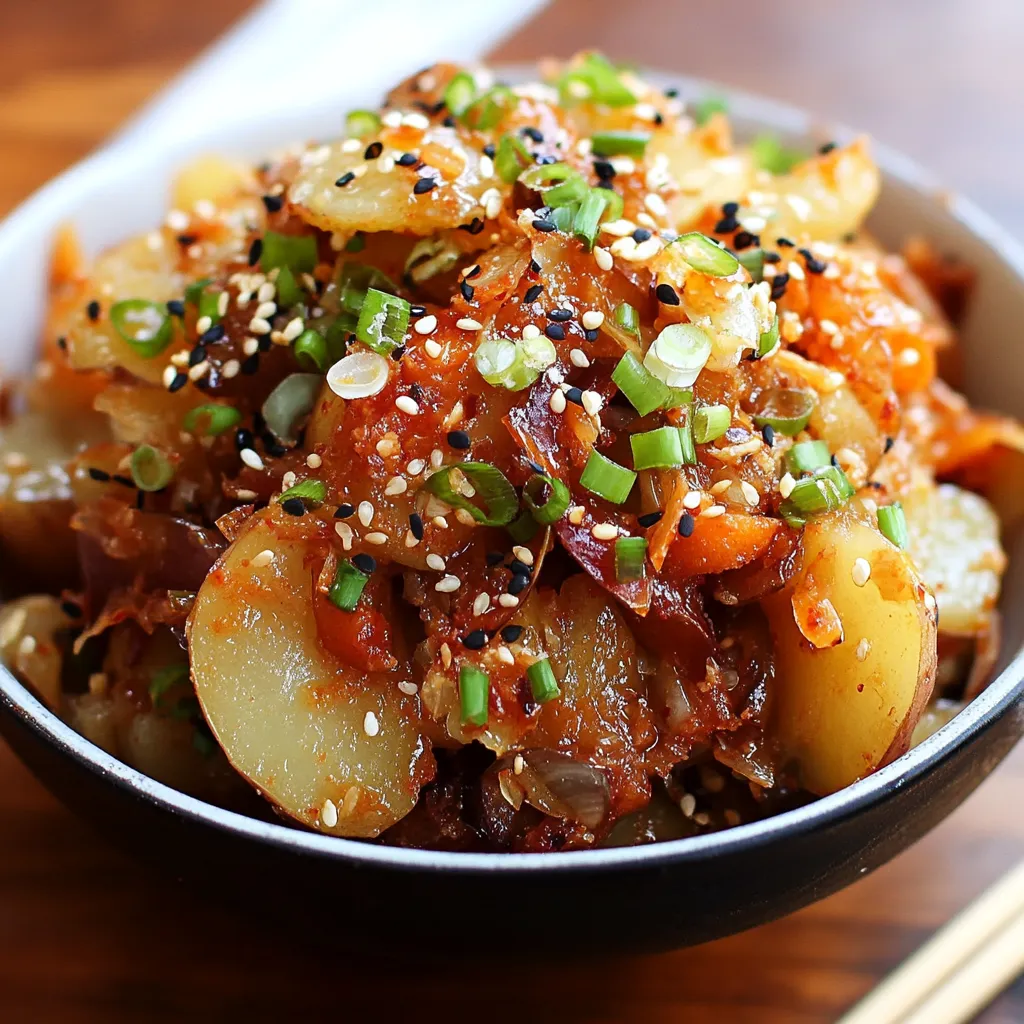 Pin it
Pin it
This irresistible Gamja Jorim transforms humble potatoes into a sweet, savory, and slightly spicy Korean side dish that pairs perfectly with any meal. The potatoes develop a beautiful caramelized exterior while soaking up the rich, glossy sauce, creating a perfect balance of flavors and textures.
I first discovered Gamja Jorim at a friend's Korean barbecue gathering, and I was instantly hooked. The sticky, sweet-savory potatoes disappeared faster than any other dish that night, and I've been perfecting my version ever since.
Ingredients
- Baby potatoes: They maintain their shape while cooking and have a creamy interior that absorbs the flavorful sauce beautifully
- Grapeseed oil: Has a high smoke point perfect for developing that golden crust on the potatoes without burning
- Soy sauce: Provides the umami foundation look for low sodium varieties to control the saltiness
- Corn syrup or honey: Creates that signature sticky glaze choose honey for a more complex flavor
- Gochugaru: Optional Korean red pepper flakes that add a gentle heat and beautiful color
- Sesame oil: Added at the end for that distinctive nutty aroma that defines Korean cuisine
- Green onions: Brighten the dish with fresh flavor and color always add some at the end for maximum impact
Step-by-Step Instructions
- Develop the Golden Crust:
- Heat grapeseed oil in a large skillet over medium heat until it shimmers. Add halved baby potatoes with a generous pinch of salt, arranging them cut-side down when possible. Let them cook undisturbed for about 3 minutes before stirring occasionally, allowing a beautiful golden crust to form over 8 to 10 minutes. This initial browning creates a flavor foundation that makes all the difference.
- Build the Aromatic Base:
- Add the diced yellow onion to the partially browned potatoes, stirring to coat with oil. Cook for about 2 minutes until the onions begin to soften, then add the minced garlic and cook for an additional minute. The garlic should become fragrant and just slightly golden but not brown, which would make it bitter. This aromatic foundation will infuse the entire dish.
- Create the Sauce:
- Pour in water or chicken broth, soy sauce, rice wine vinegar, corn syrup or honey, and gochugaru if using. Stir well to combine, making sure to scrape up any browned bits from the bottom of the pan these contain concentrated flavor. Bring the mixture to a gentle simmer, then reduce heat to medium-low and let cook uncovered for 8 minutes, allowing the potatoes to begin absorbing the sauce while cooking through.
- Add Color and Reduce:
- Add the finely diced carrots for a pop of color and subtle sweetness. Continue cooking for about 4 minutes more, stirring occasionally as the liquid reduces. You want the sauce to become sticky and glossy, coating the potatoes like a glaze. The potatoes should be fork-tender but not falling apart.
- Finish with Aromatics:
- Remove the pan from heat and add the toasted sesame oil and sliced green onions. Gently stir to distribute evenly, allowing the residual heat to release the aromatic compounds in both ingredients without cooking away their fresh qualities. This final touch adds incredible depth and fragrance.
 Pin it
Pin it
The gochugaru is my secret weapon in this recipe. While optional, these Korean red pepper flakes add a complex, slightly fruity heat that transforms the dish from delicious to unforgettable. My family was initially hesitant about spicy food, but this gentle heat converted even my spice-averse mother-in-law into a Korean food enthusiast.
Storage and Make-Ahead Tips
Gamja Jorim actually improves with time, making it an excellent make-ahead dish. Store leftovers in an airtight container in the refrigerator for up to 4 days. The potatoes will continue absorbing flavor overnight, becoming even more delicious. To reheat, warm gently in a covered skillet with a splash of water to rehydrate the sauce, or microwave at 70% power until heated through.
Ingredient Substitutions
This recipe welcomes adaptation based on what you have available. Regular russet potatoes work well when cut into 1-inch chunks. For a lower glycemic option, sweet potatoes create a delightful variation with their natural sweetness complementing the sauce. Brown sugar can replace corn syrup or honey, though the sauce might be slightly less glossy. For a vegetarian version, use vegetable broth or even plain water the sauce has enough flavor to compensate.
Cultural Significance
Jorim refers to a Korean cooking technique where ingredients are simmered in a seasoned broth until the liquid reduces to a glaze. Traditionally served as banchan one of many small side dishes accompanying Korean meals Gamja Jorim has gained popularity internationally for its addictive flavor profile. In Korean households, this dish often appears during special occasions and family gatherings, representing comfort and togetherness.
 Pin it
Pin it
This sweet-savory Korean side dish is a surefire way to impress your guests while keeping cleanup minimal.
Frequently Asked Questions
- → What is Gamja Jorim?
Gamja Jorim is a popular Korean side dish (banchan) where potatoes are braised in a sweet and savory soy-based sauce until tender and coated in a sticky glaze. The name comes from 'gamja' meaning potato and 'jorim' referring to the braising cooking technique.
- → Can I use regular potatoes instead of baby potatoes?
Yes, you can use regular potatoes, but you'll need to cut them into approximately 1-inch cubes to ensure they cook evenly and absorb the sauce properly. Baby potatoes are traditionally used for their creamy texture and ability to hold their shape during braising.
- → What is gochugaru and can I substitute it?
Gochugaru is Korean red pepper flakes with a sweet, smoky heat. If unavailable, you can substitute with a mixture of paprika and cayenne pepper (4:1 ratio), red pepper flakes, or Aleppo pepper. Adjust quantities based on your heat preference.
- → What dishes pair well with Gamja Jorim?
Gamja Jorim is traditionally served as part of a Korean meal with steamed rice and other banchan (side dishes). It pairs excellently with bulgogi, galbi (Korean BBQ ribs), bibimbap, or kimchi jjigae. The sweet-savory potatoes complement both spicy and mild Korean main dishes.
- → How long can I store leftover Gamja Jorim?
Leftover Gamja Jorim can be stored in an airtight container in the refrigerator for up to 4-5 days. The flavors often intensify overnight, making it even more delicious the next day. Reheat gently on the stovetop with a splash of water if needed to loosen the sauce.
- → Is there a vegetarian/vegan version of this dish?
Yes, this dish is easily adaptable for vegetarians and vegans. Simply use water instead of chicken broth and ensure you're using honey alternatives like corn syrup, maple syrup, or agave nectar for a fully vegan version.
